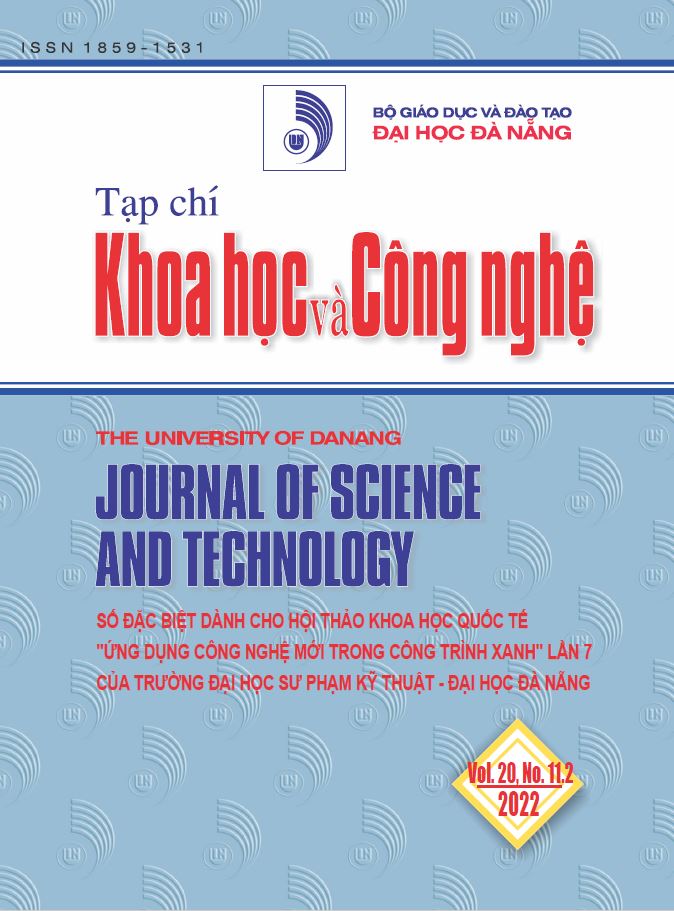Nghiên cứu dòng chảy lưu chất có tính ứng suất tới hạn qua trụ tròn đặt trong kênh
 Tóm tắt: 187
Tóm tắt: 187
 |
|  PDF: 136
PDF: 136 
##plugins.themes.academic_pro.article.main##
Author
-
Nguyễn Thành SơnTrường Đại học Sư phạm Kỹ thuật - Đại học Đà NẵngHồ Trần Anh NgọcTrường Đại học Sư phạm Kỹ thuật - Đại học Đà NẵngBùi Mai CườngTrường Đại học Sư phạm Kỹ thuật - Đại học Đà Nẵng
Từ khóa:
Tóm tắt
Bài báo trình bày nghiên cứu dòng chảy lưu chất có tính ứng suất tới hạn qua trụ tròn bị giới hạn tại Re=50-100. Huyền phù trầm tích có nồng độ khối lượng c=15-28,5% được khảo sát. Phương pháp Bingham-Papanastasiou được sử dụng để mô hình hóa đặc tính ứng suất tới hạn. Nhiều kết quả về hành vi thủy động của lưu chất có tính ứng suất tới hạn như sự hình thành vùng rắn, đường dòng, phân bố xoáy, và lực cản được báo cáo và phân tích. Cụ thể, dòng chảy ở chế độ ổn định trong toàn bộ điều kiện khảo sát. Với nồng độ kaolinite lớn (ví dụ: c=28,5%), dòng chảy thậm chí ở chế độ chảy leo; các vùng xoáy không được tìm thấy ở hạ lưu. Hơn nữa, các vùng rắn được xác định bị ảnh hưởng đáng kể bởi số Re và hiệu ứng ứng suất tới hạn. Thêm vào đó, đặc tính dòng chảy bị giới hạn bởi kênh có sự khác biệt lớn với trường hợp không bị giới hạn. Lực cản cũng được xác định phụ thuộc rất lớn vào số Re và nồng độ kaolinite.
Tài liệu tham khảo
-
[1] Shakeel, A. Kirichek, and C. Chassagne, “Yield stress measurements of mud sediments using different rheological methods and geometries: An evidence of two-step yielding”, Marine Geology, vol. 427, 2020, pp. 106247.
[2] Hulme, “The interpretation of lava flow morphology”, Geophysical Journal International, vol. 39, no. 2, 1974, pp. 361-383.
[3] Coussot, Q. D. Nguyen, H. T. Huynh, and D. Boon, “Avalanche behavior in yield stress fluids”, Physical Review Letters, vol. 88, no. 17, 2002, pp. 175501.
[4] Mahmoodzadeh and S. E. Chidiac, “Rheological models for predicting plastic viscosity and yield stress of fresh”, Cement and Concrete Research, vol. 49, 2013, pp. 1-9.
[5] Pangalos, J. M. Dealy, and M. B. Lyne, “Rheological properties of new inks”, Journal of Rheology, vol. 29, no. 4, 1985, pp. 474-491.
[6] J. Dimitriou and G. H. McKinley, “A comprehensive constitutive law for waxy crude oil: a thixotropic yield stress fluid”, Soft Matter, vol. 10, no. 35, 2014, pp. 6619-6644.
[7] K. Oppong, L. Rubatat, B. J. Frisken, A. E. Bailey, and J. R. Bruyn, “Microrheology and structure of a yield-stress polymer gel, Physical Review E, vol. 73, no. 4, 2006.
[8] Chakraborty, N. Verma, and Chhabra, “Wall effects in flow past a circular cylinder in a plane channel: A numerical study”, Chemical Engineering and Processing: Process Intensification, vol. 43, no. 12, 2004, pp. 1529-1537.
[9] Sahin and R. G. Owens, “A numerical investigation of wall effects up to high blockage ratios on two-dimensional flow past a confined circular cylinder”, Physics of Fluids, vol. 16, no. 5, 2004, pp. 1305-1320.
[10] Singha and K. Sinhamahapatra, “Flow past a circular cylinder between parallel walls at low Reynolds numbers”, Ocean Engineering, vol. 37, no. 8-9, 2010, pp. 757-769.
[11] L. Tokpavi, A. Magnin, and P. Jay, “Very slow flow of Bingham viscoplastic fluid around a circular cylinder”, Journal of Non-Newtonian Fluid Mechanics, vol. 154, no. 1, 2008, pp. 65-76.
[12] L. Tokpavi, P. Jay, A. Magnin, and L. Jossic, “Experimental study of the very slow flow of a yield stress fluid around a circular cylinder”, Journal of Non-Newtonian Fluid Mechanics, vol. 164, no. 1-3, 2009, pp. 35-44.
[13] Mossaz, P. Jay, and A. Magnin, “Criteria for the appearance of recirculating and non-stationary regimes behind a cylinder in a viscoplastic fluid”, Journal of Non-Newtonian Fluid Mechanics, vol. 165, 2010, pp. 1525-1535.
[14] Mossaz, P. Jay, and A. Magnin, “Non-recirculating and recirculating inertial flows of a viscoplastic fluid around a cylinder”, Journal of Non-Newtonian Fluid Mechanics, vol. 177, 2012, pp. 64-75.
[15] P. Bharti, R. Chhabra, and V. Eswaran, “Two-dimensional steady Poiseuille flow of power-law fluids across a circular cylinder in a plane confined channel: Wall effects and drag coefficients”, Industrial & Engineering Chemistry Research, vol. 46, no. 11, 2007, pp. 3820-3840.
[16] Biijjam and A.K. Dhiman, “CFD analysis of two-dimensional non-Newtonian power-law across a circular cylinder confined in a channel”, Chemical Engineering Communications, vol. 199, no. 6, 2012, pp. 767-785.
[17] Zisis and E. Mitsoulis, “Viscoplastic flow around a cylinder kept between parallel plates”, Journal of Non-Newtonian Fluid Mechanics, vol. 105, no. 1, 2002, pp. 1-20.
[18] Mitsoulis, “On creeping drag flow of a viscoplastic fluid past a circular cylinder: Wall effects”, Chemical Engineering Science, vol. 59, no. 4, 2004, pp. 789-800.
[19] Lin, N. Phan-Thien, J. B. P. Lee, and B. C. Khoo, “Concentration dependence of yield stress and dynamic moduli of kaolinite suspensions”, Langmuir, vol. 31, no. 16, 2015, pp. 4791-4794.
[20] M. Bui, T.C. Nguyen-Le, N.A. Ho-Tran, and V.C. Nguyen, "Flow Characteristics of Sediment Suspension in a Two-Dimensional Channel with the Presence of an Elbow," 2020 Applying New Technology in Green Buildings (ATiGB), 2021, pp. 87-93
[21] C. Papanastasiou, “Flows of materials with yield”, Journal of Rheology, vol. 31, no. 5, 1987, pp. 385-404.
[22] B. Bird, G. Dai, and B.J. Yarusso, “The rheology and flow of viscoplastic materials”, Reviews in Chemical Engineering, vol. 1, no. 1, 1983, pp. 1-70.
[23] Ookawara, K. Ogawa, N. Dombrowski, and E. Amooie-Foumeny, “Unified entry length correlation for Newtonian, power-law and Bingham fluids in laminar pipe flow at low Reynolds number”, Journal of Chemical Engineering of Japan, vol. 33, no. 4, 2000, pp. 675-678.
[24] K. Madlener, B. Frey, and H. K. Ciezki, “Generalized Reynolds number for non-Newtonian fluids”, Progress in Propulsion Physics, vol. 1, 2009, pp. 237-250.



